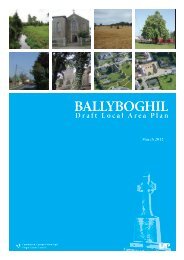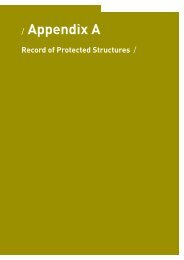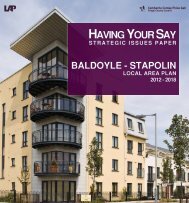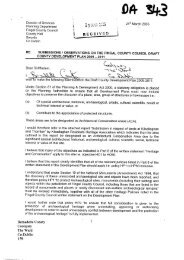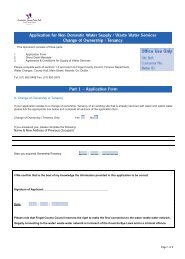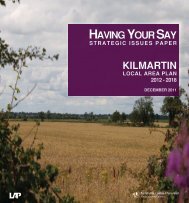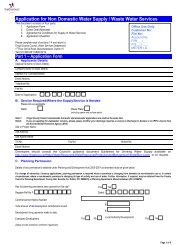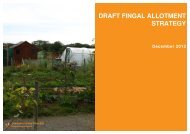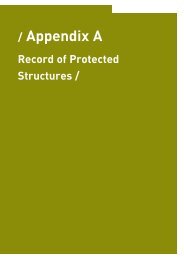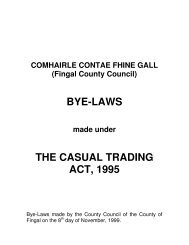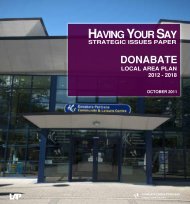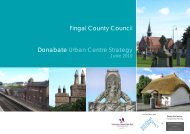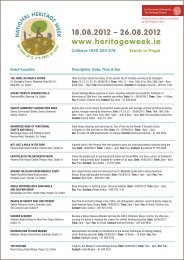Swords Masterplan - Fingal County Council
Swords Masterplan - Fingal County Council
Swords Masterplan - Fingal County Council
You also want an ePaper? Increase the reach of your titles
YUMPU automatically turns print PDFs into web optimized ePapers that Google loves.
Good things don’t happen by accident; they require forethought, commitment<br />
and enthusiasm.<br />
2.1 Urban Design<br />
Urban design is the art of making places for people. It concerns the way places<br />
work, the interaction between the different elements that make up the town-scene<br />
and urban fabric, as much as the way they look. It concerns the inter-relationships<br />
between people and places, activities and built fabric, movement and urban form,<br />
connecting and identity building, so ensuring successful towns and cities. Most<br />
people want to visit, work or live in a place where they have access to a diverse<br />
range of quality facilities, a place that is well connected and feels welcoming;<br />
a place with an excellent public realm and good homes, local shopping and<br />
entertainment venues on the doorstep; a place with good employment<br />
opportunities and easy access to education and recreation facilities.<br />
The need for good urban design to achieve a high quality and sustainable urban<br />
environment is well established at a National and EU level in such policies as<br />
the Bristol Accord, Leipzig Charter, and the UK Urban Task Force report<br />
“Towards an Urban Renaissance”.<br />
The <strong>Swords</strong> Town Centre <strong>Masterplan</strong> promotes the adoption of the principles of<br />
good urban design as a central tool of the planning and development process.<br />
2.2 Role of the <strong>Masterplan</strong><br />
The planning of the Town Centre and its relationship to the surrounding environs<br />
require an organisational logic that addresses the needs of the area as a whole.<br />
This leads to a coherent and functional model for planning changes, understanding<br />
interdependencies and prioritising investment in critical aspects of the area.<br />
The intention of the <strong>Masterplan</strong> is to both inspire confidence in and guide<br />
proposed development to 2020 (with a review in 2014, post arrival of Metro North)<br />
according to a readily understood plan with the motivating factor of realising the<br />
inherent benefits to all of a high quality Town Centre urban environment.<br />
The defined objectives and urban design framework of the <strong>Masterplan</strong> provide<br />
essential guidance for generating detailed development proposals. The plan will be<br />
used as the planning context in assessing applications/pre-planning discussions for<br />
development in the Town Centre area. As such the guidance will be subject to<br />
interpretation and the parameters set out by the plan will have varying degrees of<br />
flexibility to achieve the required outcome. The merits of detailed design proposals<br />
will require a rigorous assessment method to distinguish if acceptable urban design<br />
standards have been met within the conditions established by the <strong>Masterplan</strong>.<br />
2.2.1 MASTERPLAN AS A GUIDANCE DOCUMENT<br />
The <strong>Masterplan</strong> includes guidance in respect of building heights and street widths<br />
(where new streets are proposed) within the MC zoned lands generally, as well as<br />
further elaboration on architectural style, materials and urban form within the<br />
traditional Town Centre and in particular for the key opportunity sites identified.<br />
The <strong>Masterplan</strong> architectural and urban design guidance is given to stimulate<br />
development, introduce some degree of certainty and to encourage quality design.<br />
The indicative heights described in the <strong>Masterplan</strong> are the recommended<br />
maximum permissible heights, based on established urban design principles<br />
and in particular having regard to the following:<br />
● respecting the amenity of existing development;<br />
● positive contribution to the public realm;<br />
● heritage value;<br />
● Landmark role and<br />
S W O R D S M A S T E R P L A N<br />
2.0 <strong>Masterplan</strong> Overview<br />
● sustainable compact development.<br />
However, all such urban design and architectural guidance is indicative only,<br />
and each development proposal presented to the planning authority will be<br />
considered on its merits through the development management process.<br />
Non-compliance with the <strong>Masterplan</strong> Guidelines will not automatically preclude<br />
planning permission being granted, however, applications which propose<br />
deviations from the <strong>Masterplan</strong> Guidance must be set within a detailed urban<br />
design rationale and in the context of the urban design appraisal and guidelines<br />
set out within the <strong>Masterplan</strong> before they can be considered favourably.<br />
1 1<br />
2.3 Urban Design Criteria and<br />
Assessment Method<br />
The assessment of the adequacy of detailed development proposals requires a<br />
procedure that uses common criteria that are sensitive to the overall model and<br />
the demands of the site urban design brief.<br />
Consideration of the following key urban design criteria is essential to achieve<br />
urban design excellence:<br />
Development Form Aspects:<br />
● Structure – Layout, grain and street pattern<br />
● Open space – landscape and public realm<br />
● Density and Mix – Uses and appropriate densities<br />
● Scale – Massing, density and height<br />
● Appearance – Detail and Materials<br />
Urban Design Qualities:<br />
● Character – A place of its own identity<br />
● Continuity and enclosure – A place where public and private spaces are<br />
clearly distinguished<br />
● Quality of the Public Realm – A place with attractive and successful outdoor<br />
areas<br />
● Permeability – Ease of movement – A place that is easy to get to and move<br />
through<br />
● Legibility – A place that has a clear image and is easy to understand<br />
● Adaptability – A place that can change easily<br />
● Diversity – A place with variety and choice<br />
● Sustainability – A place that is sensitive to the environment<br />
Based on the above qualities, urban design guidance has been prepared for each of<br />
the character and development areas: (existing Town Centre (Commercial/Residential,<br />
Civic Community and the Retail/Commercial Core), Cultural Quarter, Pavilions<br />
Development Area, Metro Quarter and Barrysparks Development Area. These<br />
guidelines are contained within the relevant sections dealing with each discrete<br />
area. The above key urban design criteria and specific urban design guidance will<br />
be used in the assessment of the adequacy of detailed development proposals.




